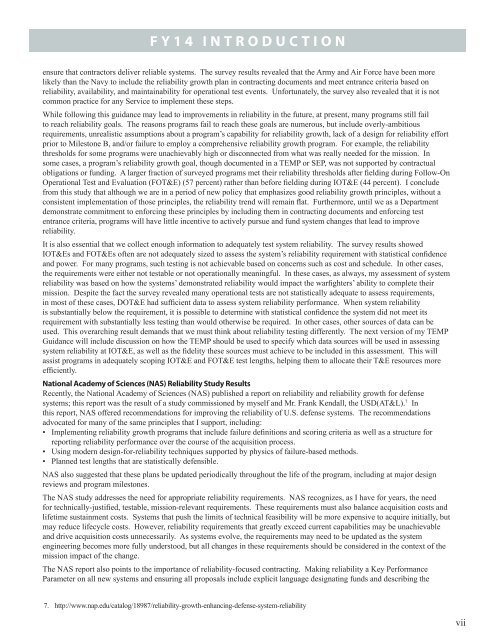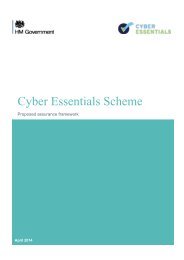2014DOTEAnnualReport
2014DOTEAnnualReport
2014DOTEAnnualReport
You also want an ePaper? Increase the reach of your titles
YUMPU automatically turns print PDFs into web optimized ePapers that Google loves.
FY14 Introductionensure that contractors deliver reliable systems. The survey results revealed that the Army and Air Force have been morelikely than the Navy to include the reliability growth plan in contracting documents and meet entrance criteria based onreliability, availability, and maintainability for operational test events. Unfortunately, the survey also revealed that it is notcommon practice for any Service to implement these steps.While following this guidance may lead to improvements in reliability in the future, at present, many programs still failto reach reliability goals. The reasons programs fail to reach these goals are numerous, but include overly-ambitiousrequirements, unrealistic assumptions about a program’s capability for reliability growth, lack of a design for reliability effortprior to Milestone B, and/or failure to employ a comprehensive reliability growth program. For example, the reliabilitythresholds for some programs were unachievably high or disconnected from what was really needed for the mission. Insome cases, a program’s reliability growth goal, though documented in a TEMP or SEP, was not supported by contractualobligations or funding. A larger fraction of surveyed programs met their reliability thresholds after fielding during Follow-OnOperational Test and Evaluation (FOT&E) (57 percent) rather than before fielding during IOT&E (44 percent). I concludefrom this study that although we are in a period of new policy that emphasizes good reliability growth principles, without aconsistent implementation of those principles, the reliability trend will remain flat. Furthermore, until we as a Departmentdemonstrate commitment to enforcing these principles by including them in contracting documents and enforcing testentrance criteria, programs will have little incentive to actively pursue and fund system changes that lead to improvereliability.It is also essential that we collect enough information to adequately test system reliability. The survey results showedIOT&Es and FOT&Es often are not adequately sized to assess the system’s reliability requirement with statistical confidenceand power. For many programs, such testing is not achievable based on concerns such as cost and schedule. In other cases,the requirements were either not testable or not operationally meaningful. In these cases, as always, my assessment of systemreliability was based on how the systems’ demonstrated reliability would impact the warfighters’ ability to complete theirmission. Despite the fact the survey revealed many operational tests are not statistically adequate to assess requirements,in most of these cases, DOT&E had sufficient data to assess system reliability performance. When system reliabilityis substantially below the requirement, it is possible to determine with statistical confidence the system did not meet itsrequirement with substantially less testing than would otherwise be required. In other cases, other sources of data can beused. This overarching result demands that we must think about reliability testing differently. The next version of my TEMPGuidance will include discussion on how the TEMP should be used to specify which data sources will be used in assessingsystem reliability at IOT&E, as well as the fidelity these sources must achieve to be included in this assessment. This willassist programs in adequately scoping IOT&E and FOT&E test lengths, helping them to allocate their T&E resources moreefficiently.National Academy of Sciences (NAS) Reliability Study ResultsRecently, the National Academy of Sciences (NAS) published a report on reliability and reliability growth for defensesystems; this report was the result of a study commissioned by myself and Mr. Frank Kendall, the USD(AT&L). 7 Inthis report, NAS offered recommendations for improving the reliability of U.S. defense systems. The recommendationsadvocated for many of the same principles that I support, including:• Implementing reliability growth programs that include failure definitions and scoring criteria as well as a structure forreporting reliability performance over the course of the acquisition process.• Using modern design-for-reliability techniques supported by physics of failure-based methods.• Planned test lengths that are statistically defensible.NAS also suggested that these plans be updated periodically throughout the life of the program, including at major designreviews and program milestones.The NAS study addresses the need for appropriate reliability requirements. NAS recognizes, as I have for years, the needfor technically-justified, testable, mission-relevant requirements. These requirements must also balance acquisition costs andlifetime sustainment costs. Systems that push the limits of technical feasibility will be more expensive to acquire initially, butmay reduce lifecycle costs. However, reliability requirements that greatly exceed current capabilities may be unachievableand drive acquisition costs unnecessarily. As systems evolve, the requirements may need to be updated as the systemengineering becomes more fully understood, but all changes in these requirements should be considered in the context of themission impact of the change.The NAS report also points to the importance of reliability-focused contracting. Making reliability a Key PerformanceParameter on all new systems and ensuring all proposals include explicit language designating funds and describing the7. http://www.nap.edu/catalog/18987/reliability-growth-enhancing-defense-system-reliabilityvii







